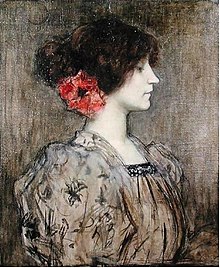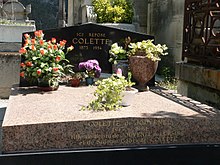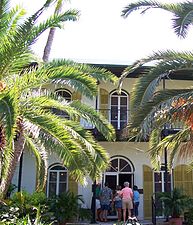

WELCOME TO --- "MIDNIGHT'S CAT MUSINGS". I'm writer and cat lover Antoinette Beard. Are the thoughts of black cats special?... While you are pondering that, if you'd like, check out my "Featured Post" and other great stuff at the very, very bottom of this page... Oh, --- and you'll find only happy cat stories here. (I can't stand that awful teary, sad stuff.) Enjoy!!!... :D =^_^=

Tuesday, August 29, 2017
Thursday, August 17, 2017
The French Author Colette Was Such A Cat Lover... =^_^=

Sidonie-Gabrielle Colette was born on January 28, 1873, to war hero and tax collector Jules-Joseph Colette and his wife Adèle Eugénie Sidonie ("Sido"), nėe Landoy, in the village of Saint-Sauveur-en-Puisaye in the département of Yonne, Burgundy. The family was initially well off, but by the time she was of school age poor financial management had substantially reduced her father's income and she attended a public school from the ages of 6 to 17—this was, nevertheless, a fairly extensive education for a girl of the period.[2][3]
Early years, 1893–1912
In 1893 she married Henry Gauthier-Villars (1859–1931) or 'Willy', his nom-de-plume,[4] a well-known author and publisher, and her first four novels—the four Claudine stories, Claudine à l'école (1900), Claudine à Paris (1901), Claudine en menage (1902), and Claudine s'en va (1903)—appeared under his name. They chart the coming of age of their heroine, Claudine, from an unconventional fifteen-year-old in a Burgundian village to the literary salons of turn-of-the-century Paris. (The four are published in English as Claudine at School, Claudine in Paris, Claudine Married, and Claudine and Annie). The story they tell is semi-autobiographical, but not entirely—most strikingly, Claudine, unlike Colette, is motherless.[5][6]
Willy, fourteen years older than his wife and one of the most notorious libertines in Paris, introduced Colette into avant-garde intellectual and artistic circles while engaging in sexual affairs and encouraging her own lesbian dalliances. It was he who chose the titillating subject-matter of the Claudine novels, "the secondary myth of Sappho...the girls' school or convent ruled by a seductive female teacher" (Ladimer, p. 53). Colette later said that she would never have become a writer if not for Willy.[7][8]
Colette and Willy separated in 1906, although it was not until 1910 that the divorce became final. She had no access to the sizable earnings of the Claudine books—the copyright belonged to Willy—and until 1912 she followed a stage career in music halls across France, sometimes playing Claudine in sketches from her own novels, earning barely enough to survive and often hungry and unwell. This period of her life is recalled in La Vagabonde (1910), which deals with women's independence in a male society, a theme to which she would regularly return in future works. During these years she embarked on a series of relationships with other women, notably with Mathilde de Morny, Marquise de Belbeuf ("Missy"), with whom she sometimes shared the stage. On January 3, 1907, an onstage kiss between Missy and Colette in a pantomime entitled Rêve d'Égypte caused a near-riot, and as a result they were no longer able to live together openly, although their relationship continued for another five years.[9][10][11]
In 1912 she married Henry de Jouvenel, the editor of Le Matin. A daughter, Colette de Jouvenel, nicknamed Bel-Gazou, was born in 1913. During the war she devoted herself to journalism, but marriage allowed her to devote her time to writing.[9][12][13]
Writing career, 1920–1954
In 1920 Colette published Chéri, portraying love between an older woman and a much younger man. Chéri is the lover of Léa, a wealthy courtesan; Léa is devastated when Chéri marries a girl his own age, and delighted when he returns to her, but after one final night together she sends him away again.[14]
The marriage to Jouvenel ended in divorce in 1924, partly due to Jouvenel's infidelities and partly to Colette's own affair with her sixteen-year-old stepson, Bertrand de Jouvenel. In 1925 she met Maurice Goudeket, who became her final husband (the couple stayed together until her death).[9][12]
Already an established writer (The Vagabond had received three votes for the prestigious Prix Goncourt), the decades of the 1920s and 1930s were Colette's most productive and innovative period.[15] Set mostly in Burgundy or Paris during the Belle Époque, her work treated married life, sexuality, and the problems of a woman's struggle for independence. It was frequently quasi-autobiographical: Chéri (1920) and Le Blé en herbe (1923) both deal with love between an aging woman and a very young man, a situation reflecting her relationship with Bertrand de Jouvenel and even Goudeket, who was sixteen years her junior.[12][9] La Naissance du Jour (1928) is her explicit criticism of the conventional lives of women, expressed in a meditation on age and the renunciation of love through the character of her mother, Sido.[16]
By this period Colette was frequently acclaimed as France's greatest woman writer. "It ... has no plot, and yet tells of three lives all that should be known", wrote Janet Flanner of Sido. "Once again, and at greater length than usual, she has been hailed for her genius, humanities and perfect prose by those literary journals which years ago ... lifted nothing at all in her direction except the finger of scorn."[17]
Last years, 1940–1954
Colette was 67 years old at the fall of France, and remained in Paris, in her apartment in the Palais Royal. Her husband Maurice Goudeket, a Jew, was arrested by the Gestapo in December 1941, and although he was released after a few months through the intervention of the French wife of the German ambassador, Colette lived through the rest of the war years with the anxiety of a possible second arrest.[18][19] During the Occupation she produced two volumes of memoirs, Journal à rebours (1941) and De ma fenêtre (1942 — the two issued in English in 1975 as Looking Backwards).[9]
In 1944 she published what became perhaps her most famous work, Gigi, telling the story of sixteen year old Gilberte ("Gigi") Alvar. Born into a family of demimondaines, Gigi is being trained as a courtesan to captivate a wealthy lover, but breaks with tradition by marrying him instead.[20]In 1949 it was made into a French film starring Danièle Delorme and Gaby Morlay, then in 1951 adapted for the stage with the then-unknown Audrey Hepburn in the title role, picked by Colette personally; the 1958 Hollywood musical, starring Leslie Caron and Louis Jourdan, with a screenplay by Alan Jay Lerner and a score by Lerner and Frederick Loewe, won the Academy Award for Best Picture.
In the postwar years, she became a famous public figure, crippled by arthritis and cared for by Goudeket who supervised the preparation of her collected works, or Oeuvres completes (1948–1950). She continued to write during these years, bringing out L'Etoile vesper (1944) and Le fanal bleu (1949), in which she reflected on the problems of a writer whose inspiration is primarily autobiographical. On her death on August 3, 1954, she was refused a religious funeral by the Catholic Church on account of her divorces, but was given a state funeral, the first French woman of letters to be granted this honour, and interred in Père-Lachaise cemetery.[18][19][9][21]
Legacy
Colette was elected to the Belgian Royal Academy (1935), the Académie Goncourt (1945, and President in 1949), and a Chevalier (1920) and Grand Officer (1953) of the Légion d'honneur.[13]
Initially considered a limited if talented novelist (despite the outspoken admiration in her lifetime of figures such as André Gide and Henri de Montherlant), she has been increasingly recognised as an important voice in women's writing.[9]
Singer-songwriter Rosanne Cash paid tribute to the writer in the song, "The Summer I Read Colette", on her 1996 album 10 Song Demo.
Truman Capote wrote a short story about her (1970) called "The White Rose".
The Colette Study Centre in France has numerous items related to Colette's life.
Jane Gilmour, Ph.D, wrote Colette’s France: Her Lives, Her Loves (Hardie Grant Books), which is a book "about Colette’s life through the places where she lived".
In 2014, SUNY Press published Shipwrecked on a Traffic Island and Other Previously Untranslated Gems (translated by Zack Rogow and Renée Morel), a collection of sketches, mini-essays, radio talks, reminiscences, and journalistic pieces written by Colette. This was the first new work by Colette to appear in English in half a century.
"Lucette Stranded on the Island" by Julia Holter, from her 2015 album Have You in My Wilderness, is based on a minor character from Colette's short story Chance Acquaintances.[22]
Sunday, August 13, 2017
Friday, August 11, 2017
Tuesday, August 8, 2017
Ernest Hemingway's House In Key West...

Ernest Hemingway with sons and kittens at Finca Vigia, Cuba, ca. 1942 (JFK Library). The photo confirms son Patrick's memory of Hemingway's cats in Cuba.
This was Hemingway's home from 1931 to 1939, although he retained title to the home until he died.[1] It is a private, for-profit landmark and tourist attraction now populated by six- and seven-toed cats that are descendants of Hemingway's cats. The author's second son, Patrick, who lived in the house, stated in a 1994 interview in the Miami Herald's "Tropic" that his father had peacocks in Key West and that he owned cats in Cuba. However, a photo on display at the Hemingway Home in Key West shows Patrick and his younger brother, Gregory, in front of the Cuban water jar near the swimming pool, and Gregory is holding a white cat named Snow White. In addition to the photo showing Patrick and Gregory with Snow White, Hemingway's wife, Pauline, wrote the following in a January 22, 1937, letter to Hemingway (who was staying at the Barclay's Hotel in New York City): "Snow White has become his (G's) fox fur that walks. Esther is having the same old cat looing troubles, with discussed alternatives of 1) getting little female, 2) letting him out and NOT worrying, which turns into letting him out and worrying, 3) castrating, 4) putting ad in paper asking for return of brown, blue-eyed cat with reward."
Descendants of Hemingway's original cats continue to live on the premises. In 2009, the cats became the subject of federal litigation after a museum visitor expressed concern about the cats' welfare. United States Department of Agriculture investigators visited the museum and subsequently ordered the museum to take measures to tag the cats for identification and to shelter them.[4] The museum fought the regulations in court but lost their case in the court of appeals, which ruled that the cats "substantially affect" interstate commerce and thus are protected by the Animal Welfare Act of 1966.[5] The house does not sell cats but does continue a selective breeding program for them.
It was in this house that Hemingway did some of his best work, including the short story classics "The Snows of Kilimanjaro" and "The Short Happy Life of Francis Macomber," his novel To Have And Have Not, and the non-fiction work Green Hills of Africa.
The house stands at an elevation of 16 feet (4.9 m) above sea level but is still the second-highest site on the island. It was originally built in 1851 by Asa Tift, a marine architect and salvage wrecker, in a French Colonial estate style,[6] out of limestone quarried from the site. As testament to its construction and location, it survived many hurricanes, and the deep basement remained, and still remains, dry.[7]
The Hemingways had spent the previous three years living in Key West but had rented housing, the last being a two-story home at 1301 Whitehead Street.[8][9] Pauline (the writer's second wife) found the Tift house for sale at a tax auction in 1931. Pauline's Uncle Gus bought it for her and Ernest, for $8,000 cash, and presented it to them as a wedding gift.[10]
Features
The house was one of the first on the island to be fitted with indoor plumbing and the first on the island to have an upstairs bathroom with running water, fed from a rain cistern on the roof. Also notable are a built-in fireplace and the first swimming pool in Key West, which was the only pool within 100 miles (160 km) in the late 30s. In November 1936, in an interview with the Key West Citizen, Hemingway showed the reporter the location he had planned for a pool. It was Pauline Hemingway, though, who spent $20,000 (equivalent in 2013 to $330,000) to have the deep well-fed pool built for her husband while he was away as a Spanish Civil War correspondent in 1938. When Hemingway returned, he was unpleasantly surprised by the cost and exclaimed, "Well, you might as well have my last cent." This penny is embedded in concrete today near the pool.[8]
In 1937, when Ernest was in Spain, Pauline hired Ernest's friend, driver, and handyman, Toby Bruce, to build the high brick wall that surrounds the house today.[11]
Another of Hemingway's loves was boxing. He set up a ring in his yard and paid local fighters to box with him. He also refereed matches at Blue Heaven, then a saloon but now a restaurant, at 769 Thomas Street.[citation needed]
Hemingway converted a urinal obtained after a renovation at Sloppy Joe's bar into a water fountain in the yard, where it remains a prominent feature at the home, filled with water from the large Cuban jar and serving as one of many water sources for the grounds' cats.[1] The grounds of the house are maintained as a garden, with many tropical plants installed after Hemingway moved to Cuba. In Hemingway's time, the grounds, like the island, were sparse and dry due to lack of water that only came later, with the Navy's installation of a water line from mainland.
The house was originally purchased for $8,000. After Hemingway's death in 1961, the house was sold by his widow, Mary, to Mrs. Bernice Dickson, the founder of the museum. A prominent feature of the dining room is a Murano glass chandelier. Upstairs, a book display shows books owned by Hemingway while he lived in Key West—including Red Pete the Ruthless by C.M. Bennett. Clearly visible is the inscription, "Given to Hemingway—1936," from Sister Ida, a nun at the local St. Joseph's convent. His writer's studio in the second floor of a free-standing carriage house, and where he stayed briefly (in the 1950s) when visiting from his home in Cuba, was once connected by a second story walkway to the master bedroom. The walkway, shown in pictures from archives, has not been reconstructed.
A garage on the property, with a caretaker's apartment on the second floor, was built to house Ernest's Buick automobile.
In 1988, the house was a filming location of the 16th James Bond movie Licence to Kill. In the scene, Bond resigns from the secret service and then flees through the garden. In protection of M, the fictional guards watch from the Key West Light across the street.
Gallery
I Visited The Hemingway House & Museum in Key West...

It was there that Ernest Hemingway wrote his short story, "The Snows Of Kilimanjaro" and his novel, "A Farewell To Arms". He was a cat lover and the descendants of his many-toed cats still live on the property.
Monday, August 7, 2017
So Sweet Little Girl With Her New Kitten...
I hope this tender and loving little girl never changes!!!... Now, --- I'm crying... =^-^=
Sunday, August 6, 2017
Saturday, August 5, 2017
Friday, August 4, 2017
The Sensuous Cologne With The Black Cat...

I remember that it was advertised with a drawing of a queenly and sensuous black female cat surrounded by her kittens...
My Sin by Lanvin (1924)
My Sin is a floral animalic. "Carnal Flower," Frederick Malle's modern perfume, would be the perfect name for this perfume.
I'm realizing that the difference between modern and vintage perfumery is like the difference between polyester and velvet, between a two-dimensional photograph and a 3-D hologram, between digital and analog. Just when I didn't think a perfume could be more beautiful, My Sin knocks me over with lush, velvety, langourous flowers. My Sin is like a beautiful woman who doesn't even have to try. All eyes are on her. Wicked, sweet, sensual. And again, she's not even my type.
Top notes: Aldehydes, lemon, bergamot, clary sage
Heart notes: Neroli, jasmine, clove, rose, Muguet (Lily of the Valley), jonquil, ylang-ylang, lilac
Base notes: Vetiver, vanilla, musk, woods, tolu, styrax, civet
Heart notes: Neroli, jasmine, clove, rose, Muguet (Lily of the Valley), jonquil, ylang-ylang, lilac
Base notes: Vetiver, vanilla, musk, woods, tolu, styrax, civet
The Siamese Cat Song...
Many black cats are part Siamese... A mating of practically any color cat with a Siamese cat often produces black kittens. If you see a black cat with a triangular face, a lean, svelte body with long back legs and a long tail who has a loud, deep voice that cat very possibly has Siamese blood.
Lestat definitely was part Siamese. He had a very triangular face, a strident meow and went around corners like a locomotive, his front end going north while his hind quarters was still heading east. :D
Thursday, August 3, 2017
A Cat's Purr...

The mechanism by which cats purr is speculative. There is a unique "neural oscillator" in the cat’s brain of uncertain significance.[1]
One hypothesis, backed by electromyographic studies, is that cats produce the purring noise by using the vocal folds and/or the muscles of the larynx to alternately dilate and constrict the glottis rapidly, causing air vibrations during inhalation and exhalation.[2] Combined with the steady inhalation and exhalation of air as the cat breathes, a purring noise is produced with strong harmonics.[3] Despite competition from various contenders, the record for the loudest purring cat continues to be held by Smokey, owned by Ruth Adams (UK). On 25 March 2011, Smokey purred at 67.7 dB.[4]
No cat can both purr and roar. The subdivision of the Felidae into "purring cats" on the one hand and "roaring cats" on the other, originally goes back to Owen (1834/1835) and was definitively introduced by Pocock (1916), based on whether the hyoid bone of the larynx is incompletely ("roarers") or completely ("purrers") ossified. However, Weissengruber et al. (2002) argued that the ability of a cat species to purr is not affected by the anatomy of its hyoid.
The "roaring cats" (lion, Panthera leo; tiger, P. tigris; jaguar, P. onca; leopard, P. pardus) have an incompletely ossified hyoid, which according to this theory, enables them to roar but not to purr. However, the snow leopard (Uncia uncia, or P. uncia), as the fifth felid species with an incompletely ossified hyoid, purrs (Hemmer, 1972).
All remaining species of the family Felidae (‘purring cats’) have a completely ossified hyoid, which enables them to purr but not to roar. Based on a technical acoustic definition of roaring, the presence of this vocalization type depends on specific characteristics of the vocal folds and an elongated vocal tract, which is rendered possible by an incompletely ossified hyoid.
Purring may have developed as an evolutionary advantage as a signalling mechanism of reassurance between mother cats and nursing kittens. Post-nursing cats often purr as a sign of contentment: when being petted, becoming relaxed,[5][6] or eating. Some purring may be a signal to another animal that the "purrer" is not posing a threat.[7]
Purring sometimes seems to be a way for cats to signal their caretaker for food. This purring has a high-frequency component not present in other purrs. This variety of purring seems to be found only in cats in a one-to-one relationship with a caretaker.[8] Cats often purr when distressed or in pain, such as in labour.[5][9][10][11] This purring may trigger a cat's brain to release a hormone which helps it in relaxing and acts as a painkiller.[12]
Wednesday, August 2, 2017
Tuesday, August 1, 2017
"The Cat Who Walked By Himself," by Rudyard Kipling...
 First published in the Ladies’ Home Journal, July 1902. Collected in Just So Stories (1902), illustrated by the author and followed by the poem “Pussy can sit by the fire and sing” (“The First Friend” in the Just So Songbook, 1911). The upper part of the illustration on p. 185 was reproduced on the dust jacket. The story Originally all the tame animals were wild, but especially the Cat: he walked by himself and all places were alike to him. The Man was wild too until he met the Woman, who chose a Cave for them to live in, lit a fire in it and hung a horsehide over the opening. She cooked a meal of wild ingredients. Then, while the Man slept, she took the bladebone of a shoulder of mutton and made a Singing Magic. This attracted the Dog, and on the next two nights she similarly lured the Horse and the Cow to visit the cave. They agreed to provide services to the couple, the Dog in exchange for roast meat and the other two for hay that she had dried by the fire. Each time the Cat followed and eavesdropped, called them fools, and went off to tell no one. On the fourth night the Cat went to the cave and smelt the warm milk from the Cow. The Woman laughed at him and told him to go back to the woods. The Cat flattered her and asked if he might never come in the Cave, sit by the fire or taste the milk. She answered that if she praised him once, twice and three times, his three wishes would be granted, but swore she never would. The Cat left, but the Bat reported to him what was happening. When he heard the Woman had a Baby, the Cat knew his time had come. He went and found that the Baby crying outside the Cave. He rubbed himself against it till it laughed. The Bat told the Woman, who blessed whatever creature was responsible, whereupon the horsehide fell down and the Cat was admitted to the Cave. The Woman was annoyed. She began to spin, but the Baby cried again, and the Cat told her to tie her spinning-whorl to a thread to pull about the floor for him to chase. This made the Baby laugh, then it clutched the Cat, who purred it to sleep. The Woman thanked him, then the fire smoked and the Cat was found warming himself. She was furious, and made a Still Magic to prevent herself from granting the third wish. In the quiet, a mouse came out and she screamed. When the Cat killed the mouse, she thanked him, and the Milk-pot cracked open, allowing him to drink. But he had made no bargain with the Man or the Dog. The man said the Cat must always catch mice or have boots and other objects thrown at him. The Cat agreed, but defiantly, so was told that three things would still be thrown. The Dog threatened to bite the Cat if he were ever unkind to the Baby, and receiving a defiant consent, promised always to chase him up a tree. Man and Dog carried out their threats; most men and all dogs will do the same, though the Cat keeps his bargain. But on moonlit nights he roams the woods or the roofs, walking by his wild lone. |
Subscribe to:
Comments (Atom)






















